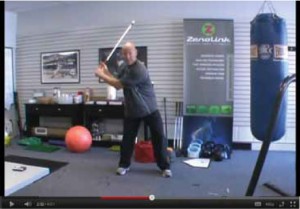
How the body moves and sequences during an activity is key to performance and avoiding injury. Utilizing training for improved golf swing performance is best accomplished through improving activity specific coordination.
The body moves in very specific patterns during the golf swing. These patterns can be referred to as activity specific coordination. The more efficient and effective the patterns of movement or coordination the better the golf swing performance.
Some keys to golf swing coordination:
- The body uses the backswing as a counter movement in an effort to more effectively load the muscles during the down swing. As a result, the body must effectively and efficiently change direction from backswing to down swing to take advantage and properly load and sequence muscular activity. Stability – lower body and torso/core –are crucial to this process. A key aspect to stability and golf coordination is the ability to rotate body segments, in particular the pelvis, upper torso and arms around a stable core. Maintaining a stable core depends heavily on lower body stability and mechanics.
- The lower body creates a force-couple, or torque, to initiate the down swing and start the speed generation process. In order to do this, the feet must first be connected solidly to the ground and weight/force must be applied into the ground through the balls of the feet. The feet grip the ground with a downward force while at the same time pushing along the surface of the ground to accelerate the pelvis. There is a very specific blend of linear component or forward weight shift and rotational component.
- The pelvis is connected to the upper body via the core musculature and a stretch-shorten process. Core muscles are rapidly stretched during the downswing and respond by contracting strongly. This action produces muscular force as well as a transference and amplification of speed between the pelvis and upper torso. The pelvis acts as an “anchor” to “whip” the upper body. This sequence and core muscular engagement are crucial to an effective and efficient development of clubhead speed. This same process occurs between the upper torso and the arms. Speed developed at the pelvis is amplified as it is passed to the upper torso and then again to the arms.
- As the clubhead nears the impact zone, the body braces to release the club and accelerate the clubhead. The ability to brace is directly related to lower body connection to the ground through the feet and core strength. At the same time, the arms must stay relaxed to allow speed to be fully transferred to the clubhead through impact.
For a good drill or exercise to learn to generate speed from the ground up, check out the Long Response Plyometric Swings video below:
(Note – if no video appears, click REFRESH on your browser)
If video still does not appear, watch it here




